We met with multimedia artist, Lua Brice, co-founder and now solo-artist of the New York-based Hovver Studio. During the interview, the artist introduced us to two of her major pieces, Liminal Scope and Folding Light, as well as some insights into what she is currently working on. We discussed her interest in sound and light phenomena, geometry and spatialized experience.
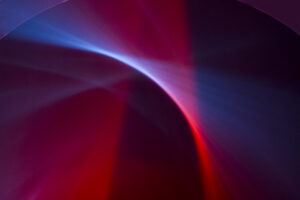
Hovver Studio, Liminal Scope I, 2017 – ongoing. Courtesy Hovver Studio
Sara Buoso: Would like to tell us about your background and in particular what made you interested in dealing with sound and light materials in virtual and immersive environments?
Lua Brice: My journey into the world of light and sound – adopted as artistic media – has been a progressive and transformative one. Growing up in Australia, I pursued a master’s degree in architecture at RMIT University in Melbourne, with a final semester exchange at Parsons School of Design in New York. While initially architecture captivated me with its focus on human-scale design and the interplay of light, space, and movement, I eventually found it limiting due to the constraints of client demands, budgets, and practical utility. Whilst it gave me an understanding of geometry and the movement of body into space, I eventually felt it did not involve all the senses to their fullest capacity. In 2012, my encounter with Anthony McCall’s Solid Light sculpture at Hamburger Bahnhof in Berlin left a profound impression on me. Witnessing light being used as an architectural element for the first time, I started creating immersive environments where you could experience an intangible experience of an interior and exterior space. McCall discovered a whole new medium, intriguing me to explore the possibilities of light as a versatile and scalable building tool, opening up new venues for investigation and creation. During my time at Parsons, I met Chris Lunney my previous collaborator, who had a background in design technology, and together we delved further into the possibilities of light and its interaction with space. Our investigations, initially conceived during a class called “Light Space Art”, propelled us to establish our own studio, where we continued our explorations with light, haze, and reflective surfaces. These endeavors ultimately culminated in the discovery and development of the Liminal Scope project. Over the years I came to understand light with its spatial qualities: it is a captivating foundational element, enabling the construction of ephemeral spaces that could be easily adjusted, scaled, and transformed. Its intangible nature, forming the basis of our entire reality, inspired my continued exploration of light as an essential medium for artistic expression and spatial investigation. Through this lens I started to look at sound in a similar way and to use them both as complementary tools for my research.
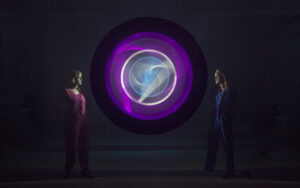
Hovver Studio, Liminal Scope I, 2017 – ongoing. Courtesy Hovver Studio
Your work references the legacy of Minimalist sculpture. However, your use of sophisticated technologies, like 3D modeling, suggests a new threshold of investigation for sculptural and multi-media practices.
The minimalist aesthetic is the deliberate outcome of our endeavor to eliminate all the non-essential elements, by concentrating solely on accentuating the revealed phenomena. We strive to create an environment and a geometry that serve as ideal backdrop for showcasing these phenomena, employing magician’s tricks, like the use of smoke and mirrors to reveal rather than conceal. My approach to techniques is grounded in an unwavering curiosity that drives me to achieve specific outcomes. Drawing from my background in architecture and fabrication, I am able to select materials that precisely fulfill the desired effects, unencumbered by the limitations of a single medium. Over the years I have also had the opportunity to work within the dynamic environment of the New Lab in the Brooklyn Navy Yard, an innovative hub for future technology that offers high-tech fabrication and tooling equipment. Surrounded by scientists and engineers focused in developing various devices and machines for real-world problem-solving, my exposure to this modern manufacturing approach has significantly broadened my understanding of materiality and expanded my perception of what is actually achievable.
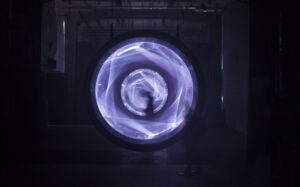
Hovver Studio, Liminal Scope II, 2017 – ongoing. Courtesy Hovver Studio
Geometry and spatialized experience are fundamental in your practice and this is explicit in Liminal Scope, which explores the limit of vision by dwelling into perception. Would you like to tell us about this installation?
Liminal Scope serves as tool for perceiving the interstitial spaces and states that often evade our notice. Within this installation, we capture the trajectory of light through space, revealing the subtle yet pervasive phenomenon of caustic substances: the shimmering effect seen at the bottom of a pool, where light undergoes conversion and dispersion. Although this phenomenon surrounds us constantly, our natural environment limits our perception of it, thus necessitating specific conditions, such as a dark space, polished surfaces, airborne particulates and a focused lighting for its spatial comprehension. By focusing on presenting this natural and devoid of specific cultural contexts occurrence, the installation invites viewers to engage directly with the intrinsic qualities of the phenomenon itself, fostering a deeper understanding of the essential characteristics of light and its interactions with the environment. This elemental approach allows a contemplation of the universal aspects of the natural world, transcending the constraints of cultural interpretation and temporal influences. Through the framing and revelation of this ethereal occurrence, Liminal Scope prompts a meditation on our inherent perceptual limitations. Harmonic frequencies and syncopated rhythms induce a contemplative ambiance, while the interplay of color and motion orchestrates a choreography of tension and release. This physical phenomenon, made perceptible through our installation, serves as a metaphor for pondering the potential limitations of our sensory perception and environmental constraints, by provoking reflections on the dimensions of reality that may elude our comprehension. Drawing parallels to the modern technological advancements that have expanded our understanding of reality, such as telescopes revealing the distant past or microscopes delving into microscopic structures, Liminal Scope provides a new lens for investigating the in-between space. By evoking a childlike sense of wonder and enabling a fresh understanding of the inherent light phenomena in our physical world, the installation fosters an introspective journey, encouraging people to explore their inner landscapes and contemplate their connection to the embodied reality.
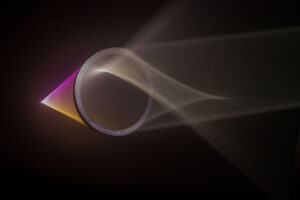
Hovver Studio, Folding Light, 2021. Courtesy Hovver Studio
In a very different way, in Folding Light your research translates into a virtual, embodied, plastic experience.
Folding Light represents a progression: the desire to immerse oneself within the effect became a key consideration for our next exploration. This new piece features a metal ring with near-parabolic mirrors on both the front and back faces, enclosed within a proportional, blacked-out room. Projectors at each end of the room are pointed to the ring, producing a sweeping, self-intersecting geometry that reflects a swallow’s tail geometric shape, named “sandpile challus” by American mathematician Thomas Banchoff – renowned for his work in exploring and communicating four-dimensional objects. The cross-sectional swallow’s tail geometry also appears in one of Salvador Dalì’s last paintings, The Swallow’s Tail, potentially influenced by the conversations with Banchoff during the Seventies. This specific form relates to the swallowtail catastrophe theory, which models systems exhibiting hysteresis, a phenomenon where a system’s output depends not only on its current input but also on its historical state. This can be commonly observed in magnetic materials, where the magnetization of the material depends not only on the current applied magnetic field but also on its past exposure. Within the exhibition space, we incorporate four speakers, two at each end of the room, tuned to create a standing wave that aligns with both the room’s dimensions and the point where light intersections occur. When the sound waves intersect themselves, they cancel, thus as one navigates the space where the light waves intersect creating a moment of punctuation in the darkness, sound naturally disappears. In this sense we adopt the geometry of the intersecting light to help people understand the invisible geometry of the sound fields in the room. Even though our work utilizes a self-intersecting geometry – firstly confined to the virtual realm of computer modeling – our original fascination did not revolve around representing the virtual. Self-intersecting geometries naturally arise when light serves as medium, being a unique material capable of traversing itself. Employing light as a foundational tool to investigate these intricate geometries, we offer people a tangible exploration of these transient and boundary-shifting phenomena. In Folding Light, the focus lies beyond the ring itself, emphasizing the invisible wave within the space phenomenon, where every element contributes to the overall art experience. The minimalistic aesthetics serve to highlight the intended focal points, stripping away distractions and fostering a heightened sense of immediacy and immaterialism for the audience. By intersecting light and sound experientially, the installation transcends traditional art boundaries, inviting participants to engage with the piece on a deeper and sensory level, encouraging a profound contemplation of the intricate connections between art, space, perception, and human experience.
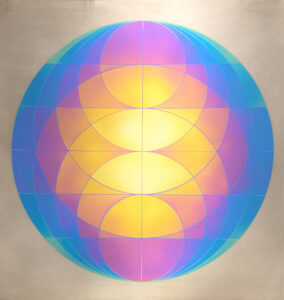
Lua Brice, Alchemy series – Formular 1.1, 2023. Courtesy the artist
What are your current and future projects?
Lately, my focus has pointed towards the development of 2D wall pieces, particularly a series that delves into the exploration of structural color. Strikingly, these pieces do not rely on pigments for their vivid hues; instead, the vibrant colors emerge from the refraction of light through a microscopic buildup of crystals on the material’s surface, akin to the way colour appears in a butterfly’s wing. To achieve this effect, I paint electricity on the metal surface, cultivating layers of crystals where time serves as tool. The embodied process to create this work becomes a movement of meditation, thus an expression to be perceived energetically. Titled The Alchemy Series, my recent works delve into the exploration of particular geometries, serving as a means to deepen my comprehension of the fundamental forms that constitute our reality. For example, in historical context, the metaphorical essence of the alchemical research has been misunderstood many times, right in the passages in which the material transformation of metals into gold was discussed. With these works, my creative process represents an inner alchemical journey, in which I meticulously strive to understand and materialize these forms within the pieces. Therefore, the artwork embodies both a tangible, physical alchemy – transforming this metal to its heightened state through the application of electricity – and an introspective alchemy – manifested through this intricate creative process.
Sara Buoso
Info:
Lua Brice
Hovver Studio
hovver.studio

She is interested in the visual, verbal and textual aspects of the Modern Contemporary Arts. From historical-artistic studies at the Cà Foscari University, Venice, she has specialized in teaching and curatorial practice at the IED, Rome, and Christie’s London. The field of her research activity focuses on the theme of Light from the 1950s to current times, ontologically considering artistic, phenomenological and visual innovation aspects.



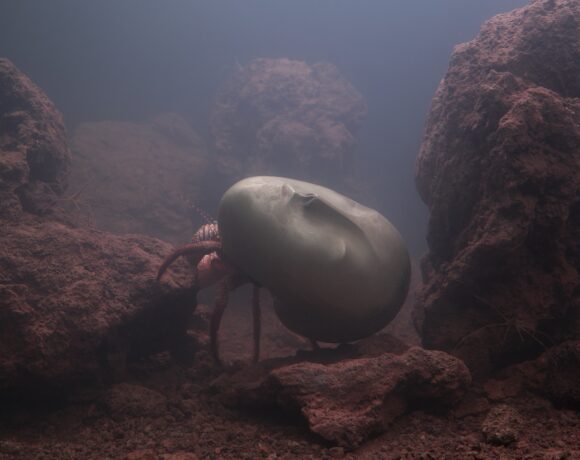
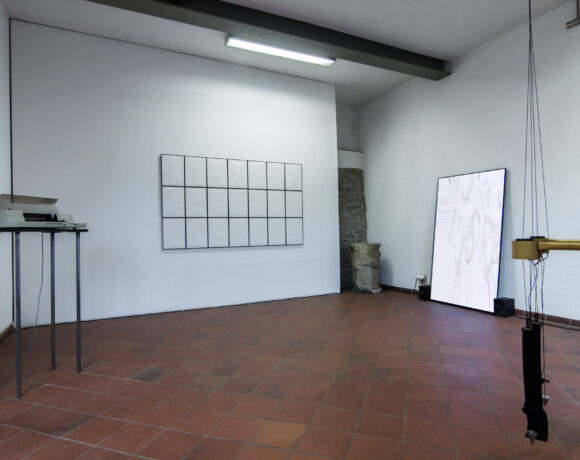

NO COMMENT